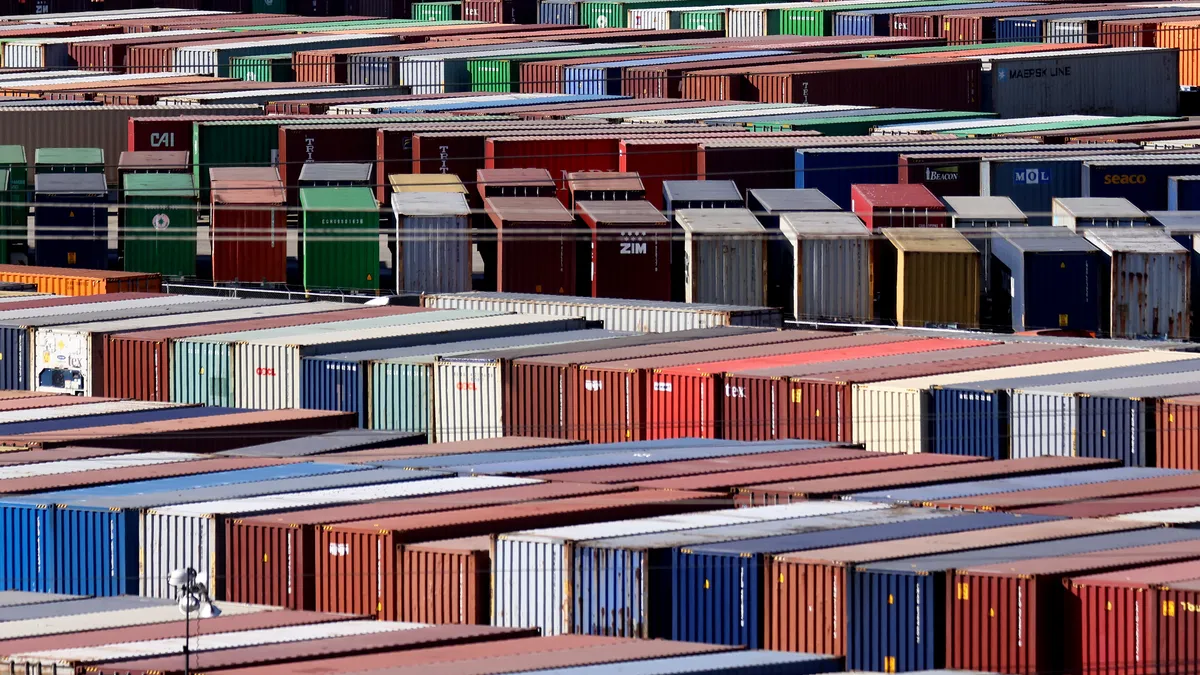LOS ANGELES — The Port of Los Angeles is making progress on reducing the number of empty containers dwelling on its docks, but many of its truck gate slots and much of its on-dock rail capacity are going unused, contributing to ongoing congestion, Executive Director Gene Seroka said during a virtual briefing Thursday.
The port handled 865,595 TEUs in January, a 3.6% increase YoY and its busiest January on record. But the average dwell time and total number of aging containers has dropped overall since October, Seroka said. Now, there are just over 9,400 containers waiting nine days or more on docks, a 75% drop since Oct. 25.
How much cargo has been cleared at the San Pedro Bay ports?
As of Feb. 11, for example, the ports reported 70% fewer "aging" containers than there were on Oct. 25.
Further improving cargo flow will require addressing the 55% percent of truck gate appointments and 30% of its rail capacity going unused, the executive director said.
"Unused truck gates and excess rail capacity are two key areas that we need to improve immediately," Seroka said.
Both are complicated issues that will take time to solve, stakeholders say.
Increased use of the port's truck gates is hampered by restrictions on empty container returns, chassis and driver HOS; shipper-dictated pickup times; and limited staffing and cargo availability, said Matt Schrap, CEO of the Harbor Trucking Association.
"There are many factors," Schrap said. "We're working with our members to figure out a more sensible approach to utilizing the available gate hours."
The 20-mile freight rail expressway that connects the San Pedro Bay ports with inland intermodal facilities has capacity for about 100 trains per day. But the Class-I railroads were running only about 30 trains per day on the corridor as of October, said Michael Leue, CEO of the Alameda Corridor Transportation Authority.
A lack of on-dock rail usage could be a product of downstream supply chain backups, Leue said, such as difficulty getting inventory from inland rail yards to their warehouses, many of which are full or near capacity.
"The indications are that [the problem] is getting the cargo out of those intermodal yards and into warehouses," Leue said. "There's just nowhere for it to go to get off that inland rail yard. And then that just ripples back through the whole system."
The Port of Los Angeles is also profiling ships for exports and empties as a surge of outgoing containers follows last year's holiday import rush, Seroka said. The port's promissory commitments with "sweeper" vessels, which call the port to pick up empties, have cleared about 107,000 TEUs of extra container capacity.
Three ocean carriers — ONE, Hapag-Lloyd and Zim — confirmed in emails to Supply Chain Dive that they had sent at least one ad-hoc sweeper vessel to San Pedro Bay for empties since late last year. Zim and CMA CGM announced incentives in December to speed the flow of loaded containers.
As the Port of Los Angeles profiles vessels for empties, it is also focusing on moving containers from near-dock facilities for work against the vessels every evening, Seroka said. He highlighted another development: a rising use of equipment interchange agreements by ocean carriers.
"Having a shipping company bring someone else's empty container back to Asia for sorting at origin ports is also helping our situation as well," Seroka said.
Labor is another ongoing supply chain challenge at the Los Angeles port and beyond. Filling the estimated 8,000 to 10,000 open jobs in California's warehouses alone will be critical, Seroka said.
ILWU dockworkers contracted more COVID-19 cases during the January spread of the omicron variant than during the entire previous year, Coast Committeeman Frank Ponce De Leon said in an email. But other parts of supply chains need to keep up with the increased cargo, too.
"If the current volume of cargo were to continue, we would require more truck drivers, available chassis, rail cars and off-dock storage facilities to temporarily hold containers until warehouses and distribution facilities have the capacity to accept them," Ponce De Leon said.
"Unloading cargo quickly has never been the problem," Ponce De Leon added. "Being able to move it off the ports in order to make room for more cargo has been the challenge."
Edwin Lopez, Sarah Zimmerman and Alejandra Salgado contributed to this article.














